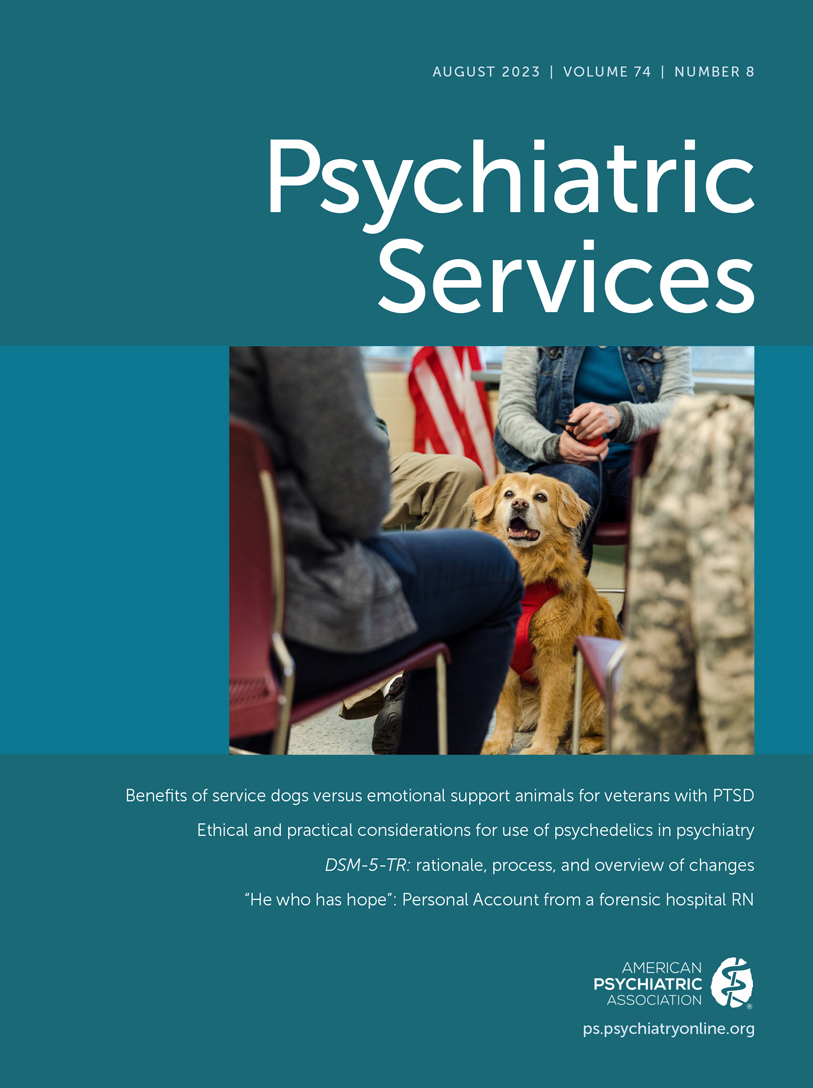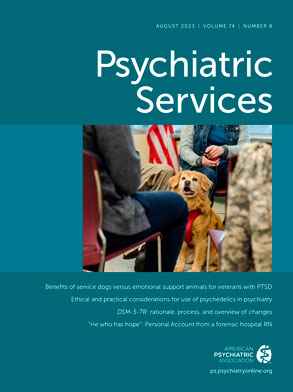July 16, 2022, marked the rollout of the nationwide 988 Suicide and Crisis Lifeline. The new Lifeline is expected to double the number of crisis calls by expanding the scope from suicide to any mental health crisis, serving more than half of all Americans (about 150 million people for >12 years) with mental health or substance use disorders or trauma exposure (
1). An estimated 39 million could be served currently by 988 (
1). Although 988 has the potential to address a broad range of mental health crises, the infrastructure needed to provide a robust continuity of care is weak. In a survey of 180 national public officials several months before the official rollout (
2), only 16% reported having developed a budget to support 988 operations. Moreover, only 48% of jurisdictions reported having any short-term crisis stabilization program, and only 28% had a facility providing urgent care for mental health problems (
2).
The 988 Implementation Act, introduced in March 2022, increases funding for mental health block grant appropriations to $2.2 billion, allocating 5%–10% for crisis services. New federal government funding of crisis programs and Medicare coverage of crisis response services are major steps forward but fall far short of investments needed to build the full crisis continuum that is needed with the observed increases in distress. Moreover, although these initiatives would fund community- and outpatient-based crisis services, the focus is on supporting the first parts of the crisis continuum: someone to talk to and someone to respond. Less attention is paid to an essential third component: somewhere to go.
The Community Mental Health Act of 1963 sought to reduce reliance on restrictive treatment settings such as state hospitals, favoring instead community-based resources for people in crisis. However, the United States has failed to realize a fully developed, comprehensive community-based mental health system. Not only are institutional settings often counterproductive in recovery, but demand for them vastly outstrips supply; in 2021, California had nearly 3,000 fewer psychiatric beds than needed (
3). Overreliance on institutional settings also risks exacerbating preexisting socioeconomic and racial disparities and incurs substantial economic costs by disproportionately institutionalizing vulnerable and marginalized racial and ethnic communities that are overrepresented in jails (
4).
Youths with mental health crises have also fared poorly during the COVID-19 pandemic. The Centers for Disease Control and Prevention reported a 31% rise in emergency department (ED) visits for mental health crises in 2020 for youths ages 12–17 years and a 51% rise in suspected suicide attempts among girls (
5). Instead of being connected to care at a time they are most in need of appropriate services, individuals often have to board in hospitals and jails because crisis care is delayed. Overreliance on EDs for evaluation and treatment of mental health crises leads to boarding of patients in settings that are already overburdened and frequently lack comprehensive mental health services (
6).
Ultimately, delivering on the mission of 988 to strengthen the continuum of crisis care depends on the availability and use of crisis stabilization services. Effective alternatives to institutional settings include peer respite facilities, crisis stabilization units, and mental health urgent care centers (
7). Unlike institutional settings such as hospitals and jails, these facilities are based in the community, respect patient autonomy, and offer flexible lengths of stay based on individual needs. We identified three barriers to creating a robust network of community-based crisis stabilization options for people in mental health crises. This information is useful for clinicians to appreciate alternatives to psychiatric hospitalization, for policy makers to support a full continuum of crisis services, and for researchers to implement evidence-based programs.
Strengthening and Structuring the Crisis Care Continuum
Unlike EDs and many inpatient psychiatric hospitals, most community-based crisis stabilization facilities can decline admission of individuals who fall outside narrow admission criteria. In California, directors of acute, subacute, and community-residential psychiatric settings faced the greatest challenges placing individuals with co-occurring medical needs and histories of criminal legal involvement (
3). Although the practice of careful client selection is understandable given variation in staffing and clinical resources among crisis stabilization settings, it limits options for many individuals with complex needs. Restrictive admissions criteria for community-based crisis services are likely a result of limited resources—both of available beds and of clinical providers. Ultimately, to offer community-based resources such as crisis stabilization units to serve more individuals in crisis, these facilities will need more funding and skilled personnel so that they are not overwhelmed by demand. Clinicians who routinely support people in crisis need strong leadership to advocate for sustained support for crisis care services and dissemination of protocols, whereas the broader group of outpatient-based clinicians may benefit from increased awareness of less restrictive evaluation and treatment options.
Some individuals will require hospital-level care, including those with complex medical needs. However, community-based options may be overlooked, and a no-wrong-door approach may be useful. Tennessee’s Department of Mental Health and Substance Abuse Services (DMHSAS) ensures that noninstitutional crisis stabilization options are exhausted before resorting to hospital admissions by tracking individuals along the crisis continuum, starting at the initial face-to-face encounter through to problem resolution. By examining trends in weekly referrals to higher levels of care, individuals waiting for crisis stabilization care, and resources that were used, the Tennessee DMHSAS reports that 63% of individuals evaluated by mobile crisis services have been diverted from hospitalization to less restrictive alternatives, including crisis response services, crisis walk-in services, crisis stabilization units, outpatient and community-based resources, and no-wrong-door crisis assessment centers (
8). The success of this program can be largely attributed to recording individuals’ experience through the continuum of crisis care, not only at face-to-face encounters; establishing standardized data collection definitions and practices; integrating data collection systems; and generating easily accessible performance “dashboards” for process improvement initiatives (
8). The DMHSAS crisis care model aims to systematically exhaust as many less restrictive treatment options (e.g., telephone counseling, mobile crisis response, and crisis respite services) for individuals in crisis as possible before considering more restrictive environments. However, the success of this model depends on both the availability and integration of individual elements of the crisis care continuum.
Defining and Funding the Continuum
As of August 2022, only four states had passed comprehensive 988-implementation legislation that addresses all facets of the crisis continuum of care; another 10 had partial legislation enacted. For many states, however, it remains more expedient to refer individuals in psychiatric crisis to institutional settings instead of less restrictive options. There is increasing recognition on the national level that this practice is unacceptable. For instance, in 2019, a federal judge ruled that Mississippi had violated the Americans With Disabilities Act because the state had not provided sufficient crisis stabilization options in the community, leading to excessive segregation in state hospitals (
9).
Traditional reimbursement models hinder the delivery of comprehensive and person-centered crisis care. Discounting the economic and human costs of poorly managed mental health crises, compared with conditions such as diabetes and cardiovascular diseases, underpins political inaction. Some health plans have not covered acute crisis and stabilization services and require individuals to pay out of pocket for crisis stabilization. However, out-of-pocket payments should occur less often in the coming years because of a recent ruling on implementation of the No Surprises Act, a bill curbing unexpected patient cost-sharing, which requires health plans to cover crisis stabilization services. Additional ways to address this and other policy-related barriers include collaboration among key stakeholders and development of a multimodal public health media strategy to shape public awareness and perception of crisis services, estimating and summarizing cost-savings from hospital and ED diversion, and coordinating with attorneys general to address legal challenges (
10). Messaging should be audience specific; for instance, for policy makers, emphasis should be given to improved outcomes and cost-savings; in contrast, general public communication should focus on the availability and descriptions of nonrestrictive mental health assistance.
The field would also benefit from forming shared definitions of the components of the continuum of care. Specific questions that need clarification include the following: What are the most effective and least restrictive methods of initial assessment (e.g., mobile crisis or ED) and for whom? What are the criteria used to determine appropriate disposition after initial assessment (e.g., inpatient hospitalization, peer respite, or mental health urgent care)? These elements and the overall crisis care system must receive consistent funding. State financial commitments and appropriations for 988-related expenses vary widely; as of this writing, only 23 states have enacted legislation to fund and implement 988. Therefore, cost-sharing arrangements between state and federal agencies for 988 and related services will need refinement, especially in resource-poor states.
Enhancing Evidence-Based Practice Through Research
Tennessee’s crisis response model, as well as a similarly successful system in Arizona (
8), conducts program refinement based on rigorous, systematic, and continuous data collection. As 988 systems are implemented, state and local leaders should establish workgroups of community stakeholders, including individuals with lived experience with mental health conditions and substance use disorders, to define evaluation metrics and action plans for addressing identified gaps in care. Most studies of mental health emergency hotlines describe only callers’ characteristics instead of behavioral outcomes (e.g., reduced suicidality) (
11). Real-world and real-time process and outcome data are essential for continuous improvement.
Ostrow and Croft (
12) outline a research agenda for peer respites, which includes an examination of the clinical and social outcomes and associated costs of these systems of care; for the process and quality of peer support; and for integration of qualitative and quantitative data. A similar research agenda should be established for other community-based crisis stabilization options such as mental health urgent care clinics. Moreover, implementation studies in diverse communities can inform approaches to adapt proven interventions for different populations, to integrate strategies that consistently support high-quality services, and to highlight benefits beyond the individual in crisis (e.g., reduced ED use) (
13).
Conclusions
If enacted as intended, the 988 Suicide and Crisis Lifeline will ensure that millions of Americans who experience a mental health crisis will receive appropriate support and care. Realizing that promise will require a full continuum of care, including effective alternatives to hospitalization and incarceration. To leverage community- and outpatient-based crisis stabilization resources, communities will need to raise awareness, overcome policy-related concerns, and strengthen real-world research into these options.
Acknowledgments
The authors extend their gratitude to Thomas Insel, M.D. (Vanna Health), Ryan McBain, Ph.D. (RAND), and Theresa Nguyen, L.C.S.W. (Mental Health America), for sharing their expertise to strengthen earlier versions of this Open Forum.

